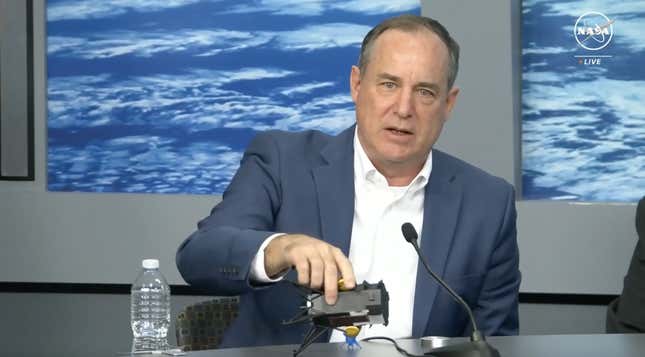[ad_1]
Intuitive Machines’ non-public lander chanced on its manner all the way down to the lunar floor and is presumably leaning over on a rock on the Moon. The car remains to be operational and flight engineers are working to assemble extra knowledge on its lower than preferrred place, the corporate mentioned.
Odysseus landed on the Moon on Thursday, overcoming a glitch that jeopardized its potential to securely contact down. Though it made it to the floor, Odie’s touchdown was not so easy, with the car getting one among its legs caught, inflicting it to tip over on its facet and presumably find yourself laying on a rock, Intuitive Machines CEO Steve Altemus revealed throughout a press convention on Friday.
“Yesterday we thought we have been upright,” Altemus mentioned. “Once we labored by way of the night time to get different telemetry knowledge, we seen that in this route [pointing downwards] is the place we’re seeing the tank residuals and in order that’s what tells us with pretty sure phrases the orientation of the car.”

“It was a fairly a spicy seven-day mission to get to the Moon,” Altemus added, and he’s not incorrect. Intuitive Machines was racing to the lunar floor to change into the primary non-public firm to land on the Moon following a sequence of failures by others. In January, Astrobotic failed in its try to achieve the Moon on account of a valve problem with its Peregrine spacecraft. In April 2023, Japan’s ispace Hakuto-R M1 crashed on the lunar floor, and Israel’s SpaceIL Beresheet lander met an analogous destiny in April 2019.
This time round, the Moon nonetheless put up a combat. Simply hours earlier than its scheduled descent, Odysseus’ laser rangefinders, that are designed to evaluate the Moon’s terrain to establish a protected touchdown spot, malfunctioned. With a purpose to assist information the lander to the floor, flight engineers uploaded a software program patch to repurpose a secondary laser on a NASA instrument that’s on board Odysseus.
The Houston-based firm seemingly broke the lunar curse with Thursday’s landing, regardless of it not being fully excellent. With the lander on its facet, it’s nonetheless receiving daylight to its horizontal photo voltaic panel, and all of its lively payloads are going through away from the floor and will subsequently be capable of function from the Moon, based on Altemus.
Intuitive Machines secured a faint sign from its lander however it’s nonetheless ready on extra knowledge to be downlinked from Odysseus. A number of the antennas that the lander is designed to make use of to speak with Earth, nevertheless, are pointed downward, which limits the mission’s potential to transmit knowledge.
The IM-1 mission is a part of NASA’s Business Lunar Payload Providers (CLPS) initiative, which goals to have a relentless stream of personal landers headed to the Moon to ship government-owned and industrial payloads. With every non-public journey that launches to the Moon, NASA and its associate firms acquire knowledge to feed into the following mission.
“As landers come down, we might ideally prefer to have them come straight down,” Prasun Desai, deputy affiliate administrator of Area Know-how Mission Directorate at NASA, mentioned through the press convention. “However as a result of there’s errors within the operations of the system, you wind up going laterally…[we’re trying to] get an understanding of that lateral motion in order that the system can counteract that and 0 out that lateral movement to come back straight down.”
Odysseus is designed to function on the lunar floor for round per week, or till the Solar units on the Moon’s south polar area. Intuitive Machines is hoping that the lander’s photo voltaic panels will be capable of obtain sufficient daylight of their present place to energy the lander by way of the approaching days.
For extra spaceflight in your life, observe us on X (previously Twitter) and bookmark Gizmodo’s devoted Spaceflight web page.
[ad_2]
Source link

